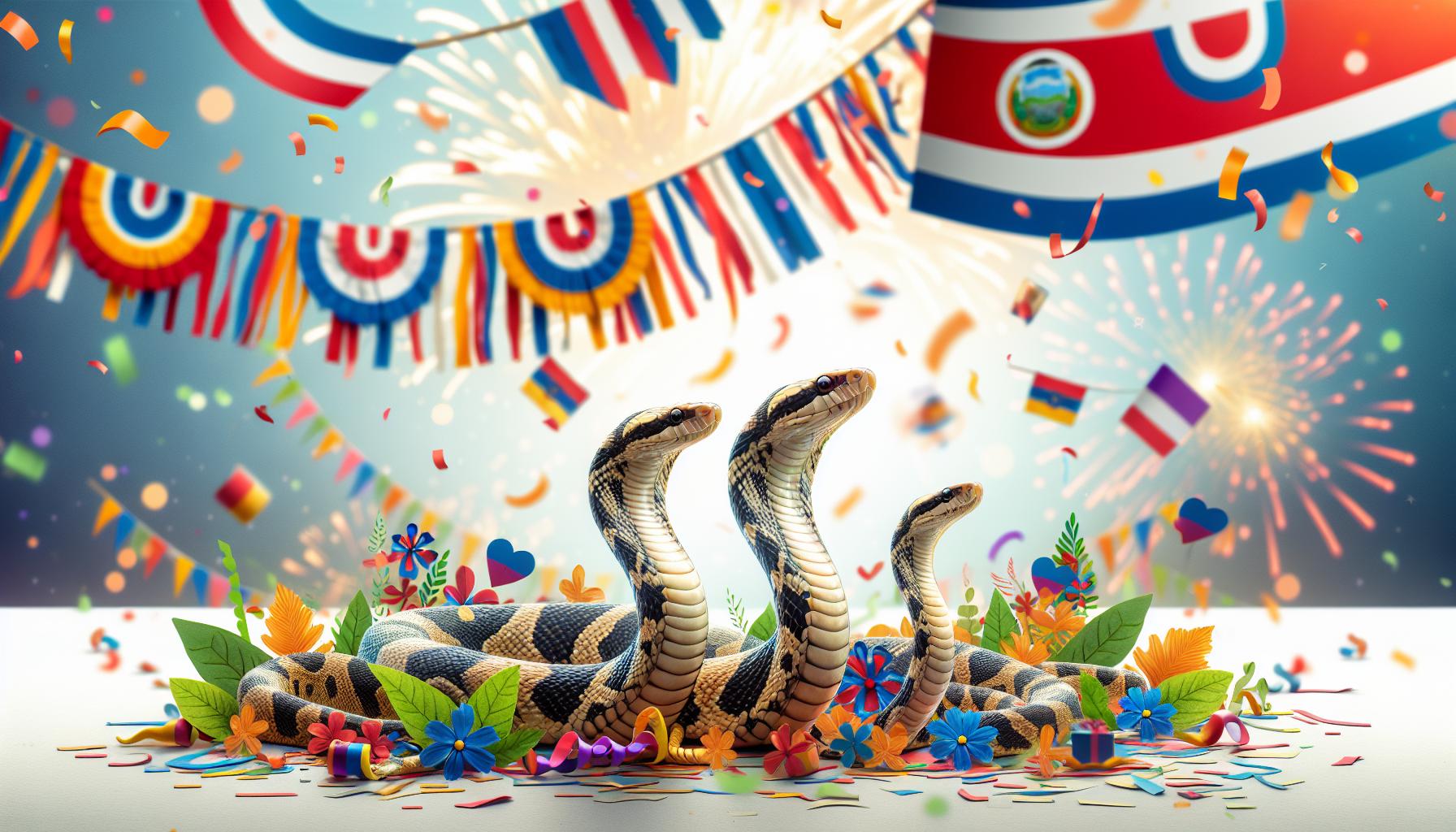Costa Rica is renowned for its rich biodiversity, but its many snake species can evoke fear in visitors. Understanding which snakes are venomous and non-venomous is crucial for safety while exploring this stunning country. This guide offers essential information on various snakes and tips for having a safe and enjoyable experience in Costa Rica.
Understanding the Snake Population in Costa Rica: Myths vs. Reality
Encountering snakes in Costa Rica can be a daunting thought for many, especially given the country’s reputation for biodiversity. However, understanding the snake population and dispelling myths surrounding them can significantly enhance your experience in this beautiful tropical paradise. While it’s true that Costa Rica is home to over 130 species of snakes, only around 22 of these are venomous, and most pose little threat to humans if left undisturbed [[2](https://enviroliteracy.org/animals/how-likely-am-i-to-see-a-snake-in-costa-rica/)].
Debunking Common Myths
Many travelers believe that Costa Rica is crawling with snakes and that encountering one is inevitable. In reality, while snakes are indeed part of the ecosystem, they often avoid human contact. Snakes are generally more interested in escaping than engaging with humans, making actual encounters relatively rare outside of specific habitats or during particular activities, such as hiking in dense jungle environments or during rainy seasons when snakes may be more active.
There are also misconceptions about the danger they present. While Costa Rica does possess several venomous species, including fer-de-lance and bushmaster snakes, the likelihood of a dangerous encounter is minimal if basic precautions are taken. Understanding which snakes are harmful can help to alleviate fears and encourage respect rather than anxiety.
Practical Safety Tips
To navigate the snake population safely, consider the following practical steps:
- Stay on Trails: Stick to well-established paths during hikes to avoid unintentionally startling a snake.
- Wear Appropriate Footwear: Boots can provide protection against bites, especially in areas known for snake activity.
- Watch Your Step: Be vigilant, particularly in high grass or rocky areas, where snakes may be camouflaged.
- Educate Yourself: Familiarize yourself with local snake species, their habitats, and behaviors.
With this knowledge, you’re better equipped to appreciate the diverse wildlife without unnecessary fear. Remember that snakes play a crucial role in maintaining the balance of Costa Rica’s ecosystems, and a respectful approach can lead to memorable and safe wildlife encounters. By understanding the realities of the snake population, you can confidently enjoy everything Costa Rica has to offer, knowing that safety and awareness are always within your control.
Encountering Snakes: What to Expect in the Wild
In the lush jungles and vibrant ecosystems of Costa Rica, encounters with snakes are not just possible—they are part of the adventure. With over 130 species of snakes inhabiting the country, ranging from harmless to venomous, understanding what to expect when you venture into these wild areas is essential for your safety and peace of mind. The experience can be both exhilarating and intimidating, as these creatures are often elusive, yet their presence is a crucial part of the biodiversity that Costa Rica is renowned for.
Identifying Common Snakes
Among the snakes you might encounter, some are well-known for their striking appearances and behaviors. The Fer-de-Lance and Bushmaster are particularly notable for their venomous attributes, while the Green Tree Viper offers a glimpse of Costa Rica’s incredible camouflage skills. Here’s a quick overview of some species:
| Snake | Type | Habitat | Behavior |
|---|---|---|---|
| Fer-de-Lance | Venomous | Lowland forests and fields | Aggressive when threatened |
| Bushmaster | Venomous | Rainforests | Typically docile but dangerous if provoked |
| Eyelash Pit Viper | Venomous | Trees and shrubs | Often found curled on branches |
| Green Iguana | Non-venomous | Trees and open areas | Generally harmless |
Tips for Safe Encounters
When exploring areas inhabited by snakes, keeping a few simple precautions in mind can significantly reduce your risk of an unpleasant encounter:
- Stay on designated trails: Avoid wandering into thick underbrush where snakes may be hiding.
- Watch your step: Always look down before you take a step, especially in areas with dense vegetation.
- Make noise: Snakes are often more afraid of you than you are of them. Making noise while walking can alert them to your presence, giving them a chance to slither away.
- Educate yourself: Familiarize yourself with the local species and their habitats. Knowing which snakes are venomous can help you react appropriately.
Embrace the thrill of exploring this biodiverse paradise by understanding and respecting its snake population. Practicing awareness and caution can lead to a rewarding wildlife experience, allowing you to appreciate the intricate role snakes play in the ecosystem while ensuring your safety.
Essential Safety Tips for Your Costa Rican Adventures
Costa Rica is renowned for its lush biodiversity, but its rich ecosystem also comes with some unique challenges, particularly concerning wildlife encounters. Understanding how to navigate these aspects can enhance your adventure while ensuring safety. One of the prime considerations for outdoor enthusiasts in this tropical paradise is the presence of snakes. Costa Rica is home to a variety of snake species, some of which can be dangerous. Thus, knowledge from guides like “Are There Snakes in Costa Rica: Safety Guide & Species Identification” can be pivotal for all travelers.
To minimize encounters with snakes and ensure your safety during treks and hikes, consider these essential tips:
Awareness and Preparation
Before setting out, educate yourself about the types of snakes that inhabit the areas you plan to visit. Familiarize yourself with both venomous and non-venomous species in Costa Rica. Many snakes, such as the fer-de-lance and bushmaster, can be found in forested regions, so staying informed will boost your confidence. Here are practical steps to take:
- Wear appropriate clothing: Long pants and sturdy hiking boots can protect your legs and feet from potential bites.
- Stick to established trails: Snakes often blend into their surroundings, so avoiding tall grass or dense underbrush reduces your risk of coming across one.
- Use a walking stick: When hiking off the beaten path, tapping the ground in front of you can alert snakes to your presence, encouraging them to move away.
What to Do If You Encounter a Snake
In the rare event that you come across a snake, it’s essential to remain calm. Many snake bites occur because of panic or sudden movements. Instead, remember to:
- Stay still: If you see a snake, stop and give it time to move away. Most snakes prefer to avoid confrontation.
- Back away slowly: If the snake does not retreat, carefully back away while keeping your eyes on it.
If someone is bitten, prompt medical attention is crucial. Dial 911, or seek the assistance of the local authorities. Familiarize yourself with the emergency services available in Costa Rica, such as the Tourism Police, who can provide vital assistance in emergencies.
By following these guidelines from “Are There Snakes in Costa Rica: Safety Guide & Species Identification”, you can enjoy your Costa Rican adventures with peace of mind. Remember, with knowledge and caution, you can make the most of this incredible environment while minimizing risks related to snake encounters.
Identifying Venomous vs. Non-Venomous Species: A Beginner’s Guide
Identifying the difference between venomous and non-venomous snakes is crucial for anyone exploring the lush landscapes of Costa Rica. With over 140 species of snakes recorded in the country, it can be daunting for beginners to distinguish which ones pose a threat. While only 23 of these species are considered venomous, recognition can save lives and enhance your appreciation for the diverse wildlife. One of the most effective approaches involves observing key visual characteristics, behaviors, and knowing specific examples.
Key Characteristics to Observe
When on the lookout for venomous snakes, pay attention to the following traits:
- Head Shape: Venomous snakes, particularly from families like Viperidae, often have triangular or arrow-shaped heads that are wider than their necks.
- Pupil Shape: Look for vertical slit-like pupils common in many venomous species, such as pit vipers. Non-venomous snakes, like the corn snake, typically have round pupils.
- Color Patterns: Bright colors can indicate toxicity. For instance, the striking hues of coral snakes serve as a warning sign. However, some non-venomous snakes mimic these colors (Batesian mimicry), so context is essential.
- Body Size: Venomous snakes are often heavier and stockier compared to their non-venomous counterparts. Ensure you also consider the environment; a thicker body may blend into the foliage.
Notable Venomous and Non-Venomous Species
To further aid in identification, refer to the following examples of both types of snakes commonly found in Costa Rica:
| Type | Species | Characteristics |
|---|---|---|
| Venomous | Fer-de-Lance (Bothrops asper) | Triangular head, aggressive, often found in a variety of habitats. |
| Venomous | Coral Snake (Micrurus sp.) | Bright red, yellow, and black bands; small size, prefers dense undergrowth. |
| Non-Venomous | Common Garter Snake (Thamnophis sirtalis) | Thin body, striped pattern, found near water bodies; harmless to humans. |
| Non-Venomous | Boa Constrictor (Boa constrictor) | Large size, pattern of browns and tans; relies on constriction rather than venom. |
Engaging with the natural beauty of Costa Rica can be both exciting and intimidating, especially when navigating the world of snakes. By familiarizing oneself with the various features that differentiate venomous from non-venomous snakes, anyone can enjoy outdoor adventures with greater confidence and safety. Always remember to maintain a respectful distance from any snake to admire its beauty without provoking it.
Incredible Snake Species of Costa Rica: A Closer Look
The diverse landscapes of Costa Rica provide a perfect habitat for a wide variety of snake species, captivating both nature lovers and wildlife enthusiasts. Among the over 140 species found in the country, a notable 22 are venomous, showcasing an impressive range of colors, sizes, and behaviors. Learning about these snakes not only enhances your appreciation for Costa Rica’s biodiversity but also equips you with essential knowledge for safe encounters in the wild.
Key Venomous Species
Among the most dangerous snakes in Costa Rica are several that demand respect due to their potent venom. Understanding these species is crucial for anyone venturing into the local rainforests or exploring the countryside.
- Fer-de-Lance (Bothrops asper): Known for its aggressive nature and potent venom, this snake is one of the most infamous in the region. It can be found in various habitats including rainforests and agricultural areas.
- Eyelash Pit Viper (Bothriechis schlegelii): This small, vibrant snake is recognized for its striking coloration and facial structures that allow it to detect heat, making it an adept predator.
- Bushmaster (Lachesis muta): As one of the largest and heaviest pit vipers, the bushmaster prefers the dense forest floors and can reach impressive lengths, making encounters both awe-inspiring and potentially dangerous.
Non-Venomous Species
While the intimidating presence of venomous snakes often steals the spotlight, Costa Rica is also home to many fascinating non-venomous species. These snakes contribute to the ecological balance by controlling pest populations and showcasing remarkable adaptations.
| Species | Description | Habitat |
|---|---|---|
| Common Boa (Boa constrictor) | This large snake is known for its impressive size and strength, often using constriction to subdue prey. | Forests, wetlands, and urban areas |
| Green Iguana (Iguana iguana) | Often mistaken for snakes due to its elongated body, this reptile primarily inhabits trees and is primarily herbivorous. | Tropical forests and coastal areas |
Understanding the behaviors and habitats of both venomous and non-venomous snakes in Costa Rica is essential for ensuring safe interactions. Keeping a respectful distance and observing these incredible creatures from afar not only protects you but also allows you to enjoy their contributions to the ecosystem. Enhancing your knowledge on how to identify these snakes is all part of navigating the rich and vibrant wildlife scene in Costa Rica, ensuring a safe adventure in one of the most biodiverse regions on Earth.
Cultural Perspectives: How Locals Coexist with Snakes
In Costa Rica, a country renowned for its rich biodiversity, snakes play a complex role in both the ecosystem and local culture. While many may approach the idea of encountering snakes with trepidation, Costa Ricans have found ways to coexist with these creatures, often viewing them through a lens of respect and understanding. For locals, snakes are not just intimidating animals; they are vital components of their natural heritage and ecosystems. This perspective fosters a balance between appreciation and caution.
Cultural Understanding and Education
The local understanding of snakes is often informed by cultural narratives and traditional knowledge. Through community-oriented educational programs, such as those aimed at the Cabecar indigenous community, information about snake behavior and species is shared, emphasizing the importance of snakes in controlling pest populations. These initiatives educate individuals on safety measures, reducing unnecessary fear while promoting coexistence with snakes in their environment [[2](https://icp.ucr.ac.cr/en/material/costa-rican-snakes-and-bite-prevention-information-guide)].
Additionally, initiatives like snake awareness campaigns highlight the effectiveness of basic safety protocols. For example, locals are encouraged to remain vigilant during the wet season, when snake activity increases. By teaching residents to recognize different species, both venomous and non-venomous, communities empower themselves to respond appropriately to snake encounters. This proactive approach reduces the number of snakebite incidents while allowing locals to appreciate these creatures as essential parts of their ecosystem [[1](https://ticotimes.net/2015/08/31/turrialba-why-the-population-explosion-of-costa-rican-snakes-near-people)].
Coexistence Strategies
To minimize encounters with snakes, many locals adopt specific strategies. One common method is maintaining clean surroundings, which discourages rodents and, consequently, snakes. In rural areas, residents often construct their homes to include barriers that deter snakes from entering living spaces. Proper landscaping and thoughtful placement of human-built structures help maintain a safe distance from potential snake habitats.
Moreover, Costa Ricans emphasize respect for wildlife, fostering an understanding that snakes are part of the ecological balance. Encounters are less frequent in well-maintained areas like resorts since high traffic naturally deters snake presence [[3](https://enviroliteracy.org/animals/should-i-be-worried-about-snakes-in-costa-rica/)]. Local wisdom teaches that if a snake is spotted, it is usually best to observe from a safe distance and let nature take its course, highlighting a cultural perspective that values life in all its forms.
Through these educational and cultural practices, Costa Ricans develop a relationship with snakes that is both respectful and informed, showcasing a unique model of how communities can coexist with wildlife, even those that evoke fear. Thus, awareness and understanding pave the way for a harmonious relationship with the rich biodiversity of the country, allowing both humans and snakes to thrive.
When to Be Concerned: Signs of Snake Activity in Your Area
In Costa Rica, encountering snakes is a reality that both locals and visitors need to prepare for. Given that the country hosts around 139 snake species, including 22 that are venomous, being aware of the signs of snake activity in your area is crucial for safety. Understanding when to be concerned about snake presence can prevent unfortunate encounters and promote a more enjoyable experience in the great outdoors.
Common Signs of Snake Activity
When you’re in a region with potential snake sightings, stay vigilant for these indicators of their presence:
- Shedding Skin: Snakes frequently shed their skin, leaving behind remnants that can be found under bushes or inside sheds.
- Tracks and Trails: Look for disturbed leaves or soil. Snakes often leave behind clear trails as they move through vegetation.
- Noises: If you hear rustling in the leaves or unusual sounds when walking through dense areas, it might be a snake moving.
- Prey Presence: An increase in small rodents or birds can indicate that snakes are nearby, as they often follow their prey.
Habitat Awareness
Being knowledgeable about the environments that snakes frequent can also provide critical insight. Snakes are often found in:
- Tall Grass and Dense Underbrush: These areas provide snakes with habitat to hide from predators and ambush their prey.
- Near Water Sources: Rivers, ponds, and wetlands attract both snakes and the animals they hunt, making these areas a hotspot for snake activity.
- Rural Locations: Farms and gardens can attract snakes due to abundant food sources like rodents.
Recognizing these signs and understanding the habitats where snakes thrive can keep you alert and informed. By adhering to best practices outlined in the “Are There Snakes in Costa Rica: Safety Guide & Species Identification,” you can enjoy your time in Costa Rica while minimizing risks associated with snake encounters.
Responsible Exploration: Minimizing Your Impact on Wildlife
Exploring Costa Rica’s lush landscapes and diverse wildlife is an exhilarating experience, particularly for those intrigued by the country’s many snake species. However, being a responsible visitor means engaging with nature in a way that minimizes your impact on wildlife and their habitats. One of the most pressing concerns for wildlife conservation is the growing effect of tourism on delicate ecosystems. As stewards of the environment, it is our duty to ensure that our adventures do not negatively affect the fauna and flora we come to appreciate.
Practice Ethical Wildlife Watching
Engaging in ethical wildlife watching is key to reducing disturbances to animals and their habitats. Here are several practical tips for enhancing your experience while safeguarding local wildlife:
- Maintain Distance: Always observe snakes and other wildlife from a safe distance. This prevents undue stress on the animals and allows you to appreciate them without intruding on their territory.
- Stay on Designated Paths: Straying from marked trails can disturb native plant life and sensitive habitats. Sticking to designated paths not only protects the environment but also helps you avoid potential snake encounters.
- Choose Responsible Tour Operators: Opt for eco-friendly tours that prioritize wildlife conservation. These operators typically follow guidelines that promote minimal disruption to animal behavior.
Educate Yourself and Others
Knowledge is a powerful tool in responsible exploration. Understanding the snakes of Costa Rica, as outlined in resources like the ‘Are There Snakes in Costa Rica: Safety Guide & Species Identification,’ equips you to identify species correctly and recognize their ecological importance. Share this knowledge with fellow travelers to promote a collective consciousness regarding wildlife conservation efforts.
Leave No Trace
One of the simplest yet most impactful ways to minimize your footprint while exploring is to adhere to the “Leave No Trace” principles. These guidelines encourage you to leave natural areas as you found them, ensuring that wildlife remains undisturbed and habitats intact. Here are key practices to adopt:
- Pack out anything you bring in, including food wrappers and litter.
- Avoid touching or collecting plants, animals, or rocks without understanding the ecological impact.
- Be cautious with noise levels, as loud sounds can lead to stress for local fauna.
By embracing these principles and the insights shared in ‘Are There Snakes in Costa Rica: Safety Guide & Species Identification’, you not only enhance your own exploration but also contribute positively to the conservation of one of the most biodiverse regions on the planet.
Stories from the Trail: Memorable Snake Encounters and Lessons Learned
As you traverse the lush landscapes of Costa Rica, the vibrant sounds of wildlife surround you, often accompanied by the slithering presence of snakes. While these reptiles can be intimidating, many encounters can lead to unforgettable experiences and valuable lessons. One common encounter involves the Central American Indigo Snake, a non-venomous, yet highly predatory species known to inhabit areas with ample ground cover. Observers often note how this snake skillfully hunts various creatures, from bird eggs to small mammals, demonstrating the delicate balance of Costa Rica’s ecosystem [1].
During a hike through the rainforests of Corcovado National Park, a traveler shared a gripping story of stumbling across a fer-de-lance, one of Costa Rica’s most venomous snakes. The snake was coiled and basking in the sun with its warning coloration vividly on display. Instead of panicking, the hiker recalled the advice from local guides, allowing them to maintain a safe distance while observing the snake’s behavior. This encounter highlighted the critical lesson of respecting wildlife; understanding that while snakes may evoke fear, they are an essential part of the forest’s health and should be appreciated rather than feared.
Another memorable experience occurred at a resort in Guanacaste, where guests were greeted by an unexpected visitor—a harmless garden snake. Rather than shooing it away, the resort staff took the opportunity to educate guests about local snake species and the importance of biodiversity. This gentle interaction demystified snakes for many and turned initial fear into fascination. By fostering a sense of respect and curiosity, such experiences can transform one’s understanding of wildlife encounters, reinforcing the key message from Are There Snakes in Costa Rica: Safety Guide & Species Identification—knowledge is power when navigating these natural settings.
Ultimately, each snake encounter on the trails of Costa Rica serves as a reminder of the diverse life intertwined within our planet’s ecosystems. Whether it’s recognizing a non-venomous species like the Central American Indigo or respecting the space of a venomous fer-de-lance, these moments can enhance our appreciation for nature. Thus, as you embark on your own adventure, keep the wisdom gained from past encounters in mind—stay calm, observe, and learn from the remarkable reptiles that call Costa Rica home.
FAQ
Are there dangerous snakes in Costa Rica?
Yes, there are several species of dangerous snakes in Costa Rica, including the fer-de-lance and the eyelash pit viper. These snakes possess venom that can be harmful or even deadly to humans.
When exploring Costa Rica’s diverse ecosystems, be aware of your surroundings, especially in dense jungles or near water sources. Proper footwear and paths can help minimize encounters with snakes. For detailed safety tips, consult our safety guide on this topic.
What types of snakes can I expect to see in Costa Rica?
Costa Rica is home to both venomous and non-venomous snakes, including the bushmaster and the cute but toxic eyelash viper. The diversity makes the region a fascinating study for enthusiasts.
While you may encounter a variety of snakes, it’s essential to remember that most snakes are not aggressive and will avoid humans if left undisturbed. For a comprehensive list of common snakes, visit this resource.
How can I avoid snake bites while hiking in Costa Rica?
To avoid snake bites, wear sturdy boots and long pants, stick to marked trails, and watch where you step. Staying alert is key, especially in lush vegetation.
Snakes often blend into their surroundings, making them hard to spot. If hiking with a group, remain close together, as a larger presence may deter snakes from coming near. Learn more about safety precautions in our safety guide.
What should I do if bitten by a snake in Costa Rica?
If bitten by a snake, seek immediate medical attention. Do not attempt to suck out the venom; instead, keep the bite area immobilized and as still as possible.
It’s crucial to identify the snake as precisely as possible, but do not risk further injury by approaching it. The hospitals in Costa Rica are equipped to handle snakebite cases, and providing medical personnel with details can aid in timely treatment. Familiarize yourself with local emergency numbers before hiking.
Can I find non-venomous snakes in Costa Rica?
Absolutely! Costa Rica hosts many non-venomous snakes, such as the Central American indigo snake and the green iguana, which play vital roles in the ecosystem.
These snakes are often beneficial, controlling pest populations. Spotting them can be an exciting part of your wildlife experience in Costa Rica. For more fascinating snake species, check the article on common snakes.
Why do snakes come out more during certain times of the year?
Snakes are more active during specific seasons due to factors like temperature and food availability. Generally, they tend to be more visible during the rainy season when their prey is abundant.
During these times, keep an eye out while walking, especially near water sources where they might hunt. Understanding their behavior can greatly enhance your wildlife watching experience.
Are there guided tours to learn about snakes in Costa Rica?
Yes, there are several guided tours available that focus on the wildlife of Costa Rica, including snakes. These tours provide valuable insights into the local ecosystem.
Participating in a tour can enhance your understanding of snake behavior and habitats while ensuring safety through knowledgeable guides. It’s a great way to see these fascinating creatures up close in their natural environment.
Insights and Conclusions
As you conclude your journey through the fascinating world of snakes in Costa Rica, remember that this enchanting country is teeming with life, including its remarkable serpentine inhabitants. While the thought of encountering snakes might be daunting, knowledge is your greatest ally. With over 130 species, Costa Rica hosts both stunningly beautiful and potentially dangerous snakes, such as the venomous fer-de-lance and the striking eyelash pit viper. By learning to identify these species and understanding their habitats, you can explore the lush rainforests and wildlife reserves with confidence.
Picture yourself walking along a winding trail, the sounds of vibrant wildlife surrounding you, as you keep an eye out for the infrequent but mesmerizing sight of a snake basking in the sun. Conversations with local guides reveal stories of their encounters with these creatures, often filled with respect for nature’s balance and an admiration for the snakes’ role in the ecosystem.
Take the time to equip yourself with practical tips on how to avoid snake bites, ensuring your safety while immersing in the natural wonders that Costa Rica offers. Whether you are an adventurous traveler, a family on a memorable vacation, or an expat looking to embrace the Costa Rican lifestyle, there’s a place for you in this vibrant landscape.
So go ahead—explore with curiosity, respect the local wildlife, and dream big about the adventures that await you in Costa Rica. Your next great story could very well be just around the corner!






